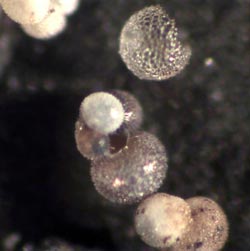Tiny Marine Organisms Reflect Ocean Warming

Image credit: (c) 2002 David Field <br>Foraminifera (forams) are small, amoeba-like organisms that live inside shells ("tests") such as those shown here. These forams were collected from the waters overlying the Santa Barbara Basin.
Sediment cores collected from the seafloor off Southern California reveal that plankton populations in the Northeastern Pacific changed significantly in response to a general warming trend that started in the early 1900s. As ocean temperatures increased, subtropical and tropical species of small marine organisms called foraminifera (forams) became more abundant. Forams that live in cooler waters decreased, especially after the mid-1970s. These changes are unlike anything seen during the previous 1,400 years. Oceanographer David Field discovered these dramatic changes during his Ph.D. work at Scripps Institution of Oceanography at the University of California, San Diego. He currently works as a postdoctoral fellow at the Monterey Bay Aquarium Research Institute (MBARI). Field and his co-authors describe their findings in the current issue of Science magazine.
Foraminifera are small, amoeba-like organisms that live inside tiny shells (“tests”) several of which might fit on the head of pin. Most forams live near the surface of the world’s oceans. Different species of forams live in ocean waters of different temperatures. When forams die, they sink to the seafloor, where their shells are often preserved as fossils in seafloor sediments.
Field studied fossilized forams in one- to three-meter-long sediment cores collected at the bottom of the Santa Barbara Basin, off Southern California. In this area, dead plankton and sediments settle onto the seafloor to form distinct annual layers similar to growth rings in a tree. At 600 meters beneath the ocean surface, seawater in the Santa Barbara Basin contains very little oxygen, so few bottom-dwelling animals disturb the sediments and the annual layers remain relatively intact.
In conducting this study, Field worked with Timothy Baumgartner and Vicente Ferreira-Bartrina of Centro de Investigación Científica y de Educación Superior de Ensenada, Mexico and with Christopher Charles and Mark Ohman of Scripps Institution of Oceanography at the University of California, San Diego.
Field and his coauthors examined yearly sediment layers that were formed up to 1,400 years ago. Counting the different species of foraminifera in each layer, they discovered that many species of tropical and subtropical forams became more abundant after about 1925. Although previous studies have shown an ocean warming trend beginning at about this time, scientists have debated how much of this warming trend was due to natural variability. In order to address this issue, scientists needed more long-term data. Field’s data set extends far enough back in time to demonstrate that the 20th century warming trend surpassed the range of natural variability.
Many previous studies have shown that a rapid warming and a dramatic change in eastern North Pacific ecosystems occurred in the mid-1970s. At this time, species of plankton, kelp, fish and seabirds that prefer warmer waters increased and species favoring colder conditions decreased. Most scientists agree that part of the warming of the global oceans and atmosphere since the mid-1970s has been caused by human emissions of greenhouse gases. However, it has been unclear whether the ecosystem changes at this time were associated with anthropogenic warming. Field’s sediment cores show that tropical and subtropical species of forams became even more abundant during this period while forams that prefer cooler waters decreased. The resulting foram community was unlike anything seen during the last 1,400 years. These long-term data indicate that the ecosystem changes since the mid-1970s are best explained by anthropogenic warming.
According to Field, “These data show that ocean warming has been affecting foram populations prior to the late twentieth century. However, changes since the 1970s have been particularly unusual, and show that ocean ecosystems in the northeastern Pacific have passed some threshold of natural variability.” He also points out that most scientific data about the ocean have been collected during recent decades, after ocean temperatures and marine ecosystems had already begun to change. As Field notes, “It’s a classic case of ’shifting baselines’—conditions that scientists think of as normal today might actually be very atypical when you look back a few hundred years.”
This study provides a long-term context for many other studies of oceanographic and ecological conditions off the California coast. It was conducted as part of the National Science Foundation’s Long-Term Ecological Research (LTER) program. The LTER program supports ecological research over long time periods in a variety of terrestrial and marine ecosystems. The research was supported by the Achievement Rewards for College Students-Los Angeles division, the University of California ship funds and Coastal Initiatives, the National Oceanic and Atmospheric Administration, S. and B. Kimmich, the National Science Foundation and the California Current Ecosystem LTER.
Media Contact
All latest news from the category: Ecology, The Environment and Conservation
This complex theme deals primarily with interactions between organisms and the environmental factors that impact them, but to a greater extent between individual inanimate environmental factors.
innovations-report offers informative reports and articles on topics such as climate protection, landscape conservation, ecological systems, wildlife and nature parks and ecosystem efficiency and balance.
Newest articles

How marine worms regenerate lost body parts
The return of cells to a stem cell-like state as the key to regeneration. Many living organisms are able to regenerate damaged or lost tissue, but why some are particularly…

Nano-scale molecular detective
New on-chip device uses exotic light rays in 2D material to detect molecules. Researchers have developed a highly sensitive detector for identifying molecules via their infrared vibrational “fingerprint”. Published in Nature…

Novel CAR T-cell therapy
… demonstrates efficacy and safety in preclinical models of HER2-positive solid tumors. The p95HER2 protein is found expressed in one third of HER2+ tumors, which represent 4% of all tumors….



